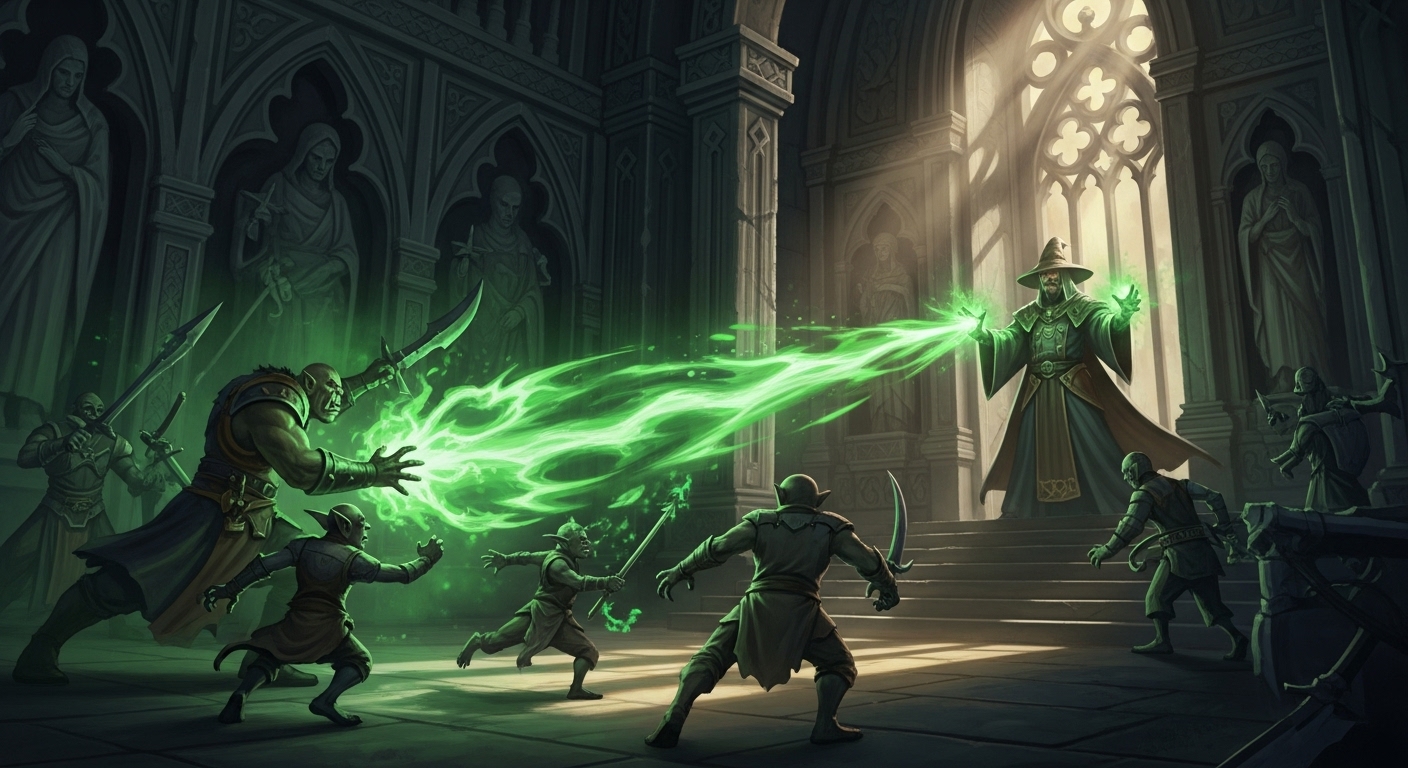Compulsion

- Level: 4
- School: Enchantment
- Class: Bard
- Casting Time: Action
- Range: 30 feet
- Components: V, S
- Duration: Concentration, up to 1 minute
Each creature of your choice that you can see within range must succeed on a Wisdom saving throw or have the Charmed condition until the spell ends.
For the duration, you can take a Bonus Action to designate a direction that is horizontal to you. Each Charmed target must use as much of its movement as possible to move in that direction on its next turn, taking the safest route. After moving in this way, a target repeats the save, ending the spell on itself on a success.
Tactical Usage
Battlefield Control: Compulsion provides ongoing forced movement control over multiple targets simultaneously. This 4th-level enchantment spell excels at repositioning enemy groups and controlling battlefield positioning.
Optimal Timing: Most effective when you can force enemies into disadvantageous positions, environmental hazards, or away from strategic objectives.
Resource Management: Uses a 4th-level spell slot - available from character level 7+. Concentration requirement demands protection but provides ongoing control value.
Target Selection: Choose creatures strategically - high-value targets or grouped enemies that can be repositioned for maximum tactical advantage.
Spell Combinations
Synergistic Spells:
- Environmental Hazards: Force movement into spike growth, wall of fire, or other area effects
- Opportunity Attacks: Drive enemies past allies for reaction attacks
- Terrain Control: Combine with difficult terrain to reduce enemy effectiveness
Class Feature Interactions:
- Metamagic (Heightened): Force failed saves on priority targets
- War Magic: Combine movement control with cantrip damage
- Bardic Inspiration: Coordinate with allies to capitalize on repositioning
Multi-Caster Coordination: Multiple enchanters can create complex movement patterns and battlefield control zones.
Material Component Details
Component Acquisition: No material components required - only verbal and somatic components needed.
Component Handling: Simple V, S casting allows flexible deployment in various combat situations.
Roleplay Opportunities: The commanding gesture and vocal direction reflect character authority and magical style.
Economic Considerations: No costs make this spell economically viable for tactical use without component concerns.
Creator Notes
Encounter Balancing: Provides significant battlefield control that can separate enemy groups or force disadvantageous positioning.
NPC Usage: Enemy bards can use this to disrupt party formations, force positioning mistakes, or drive characters into hazards.
Environmental Considerations: Terrain features like cliffs, hazards, or chokepoints dramatically enhance the spell's effectiveness.
Campaign Integration: Excellent for tactical encounters where positioning matters more than raw damage output.
Environmental Interactions
Terrain Effects: Cliffs, water, difficult terrain, and hazards make forced movement more impactful. Indoor spaces limit movement options.
Weather Influence: No direct weather effects, though slippery conditions might affect forced movement consequences.
Structural Interactions: Walls, barriers, and obstacles affect possible movement directions. Targets take safest available routes.
Elemental Interactions: Forced movement into elemental hazards (lava, acid pools) creates additional damage opportunities.
Common Rulings & Clarifications
Timing Questions: Bonus action to designate direction each turn. Targets move on their next turn after direction is given.
Target Limitations: Must be able to see targets for initial casting. Can choose which creatures to affect within range.
Duration Interactions: Concentration up to 1 minute. Targets get new saves after each forced movement.
Mechanical Interactions: Targets must use "as much movement as possible" in designated direction via safest route available.
Alternative Applications
Non-Combat Uses: Crowd control during riots, directing traffic flow, or guiding groups through complex environments.
Social Encounters: Force hostile negotiators away from strategic positions, though this typically escalates conflicts.
Exploration Applications: Guide lost NPCs toward safety, force guards away from secure areas, or direct creatures through maze-like environments.
Utility Functions: Emergency evacuation assistance, though the charm effect might cause panic when discovered.
Related Spells
Same School: Other enchantment spells like charm person (1st level single target), hold person (2nd level paralysis), dominate person (5th level total control).
Similar Effects: command (1st level single action), suggestion (2nd level complex instruction), mass suggestion (6th level group suggestion).
Progression Options: command (1st level immediate action), suggestion (2nd level detailed instruction), dominate person (5th level complete control).
Complementary Magic: spike growth (movement hazards), wall of fire (positioning targets), misty step (escape forced movement).
Scaling Analysis
Level Progression: Solid mid-level battlefield control that remains useful for tactical positioning throughout campaigns.
Upcast Benefits: No direct improvement from higher spell slots, but multiple high-level targets justify the 4th-level slot cost.
Campaign Phases: Peak effectiveness in mid-level play (7-12) where positioning tactics become crucial for encounter success.
Comparative Value: Good crowd control option that competes with damage spells but provides unique positioning capabilities.
Narrative Flavor
Casting Description: Your voice carries irresistible authority as magical compulsion takes hold, forcing targets to obey your directional commands.
Effect Manifestation: Affected creatures move with reluctant determination, their bodies obeying despite their conscious resistance to the magical compulsion.
Personal Style: Bards might use musical commands, while other casters employ authoritative gestures and imperious vocal directions.
World Integration: Represents intermediate mind control magic that affects multiple targets, often associated with battlefield command and tactical manipulation.